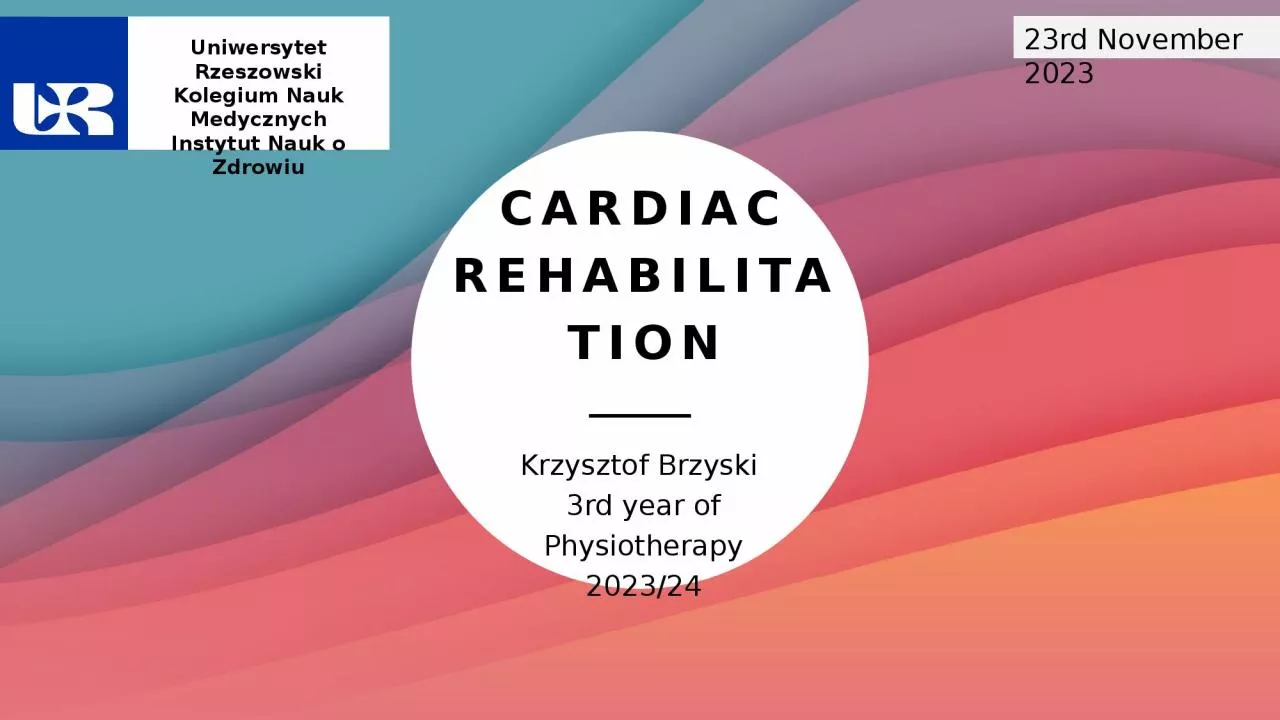

of Physiotherapy 202324 Cardiac rehabilitation Uniwersytet Rzeszowski Kolegium Nauk Medycznych Instytut Nauk o Zdrowiu 23rd November 2023 Agenda 1 Glossary 2 General structure of the circulatory system ID: 1041612
Download Presentation The PPT/PDF document "Krzysztof Brzyski 3rd year" is the property of its rightful owner. Permission is granted to download and print the materials on this web site for personal, non-commercial use only, and to display it on your personal computer provided you do not modify the materials and that you retain all copyright notices contained in the materials. By downloading content from our website, you accept the terms of this agreement.
1. Krzysztof Brzyski 3rd year of Physiotherapy2023/24Cardiac rehabilitationUniwersytet RzeszowskiKolegium Nauk MedycznychInstytut Nauk o Zdrowiu23rd November 2023
2. Agenda1. Glossary2. General structure of the circulatory system - Structure of the heart3. General structure of the circulatory system - Structure of arteries and veins4. Blood circulation in the human body - Small and large circulation5. Risk factors for cardiovascular diseases6. Physiotherapeutic approach in a selected disease entity7. Quiz8. Bibliography
3. Glossary1. Artery – Tętnica2. Aorta – Aorta3. Superior/inferior vena cava - Żyła główna górna/dolna4. Bicuspid valve (Mitral valve) - Zastawka dwudzielna (Zastawka mitralna)5. Tricuspid valve - Zastawka trójdzielna6. Right atrium - Prawy przedsionek7. Right ventricle - Prawa komora8. Coronary heart disease - Choroba wieńcowa9. Atherosclerosis – Miażdżyca10. Chest pain - Ból w klatce piersiowej11. Shortness of breath – Duszność12. Cardiac arrhythmias - Zaburzenia rytmu serca13. Systemic circulation - Obieg krwi duży (układ krążenia ogólnoustrojowego)14. Pulmonary circulation - Obieg krwi mały (układ krążenia płucnego)15. Arrhythmia – Arytmia16. Heart rate - Tętno (częstość rytmu serca)
4. General structure of the circulatory system - Structure of the heartRight atriumLeft atriumRight ventricleLeft ventricleTricuspid valveBicuspid valve (Mitral valve)Aortasuperior vena cavainferior vena cavaPulmonary veinshttps://pl.wikipedia.org/wiki/Zastawki_serca
5. General structure of the circulatory system - Structure of arteries and veins1. Outer membrane2. Middle membrane3. Inner membraneVeinArteryhttps://zpe.gov.pl/pdf/PHaLJW4WW
6. Blood circulation in the human body - Small and large circulationPulmonary circulationSystematic circulationhttps://fizjoterapeuty.pl/uklad-krwionosny/krwiobieg.html
7. Risk factors for cardiovascular diseases
8. Physiotherapeutic approach in a selected disease entityHealthy arteryArtery with accumulated atherosclerotic plaqueatherosclerosisCoronary heart disease (ischemic heart disease)https://upacjenta.pl/poradnik/miazdzyca
9. coronary heart diseasePhysiotherapeutic goals in the treatment of coronary heart disease:1. Improving the heart's function by reducing peripheral resistance, 2. Slowing down heart activity,3. Enhancing its blood supply.
10. coronary heart disease rehabilitation plan(model a)Period 1Period 2Period 31 day2 days3-5 days5-10 min.10-15 min.15-20 minPosition for exercises- Lying position- Semi-sitting position- Sitting position- Sitting position- Sitting position- Standing position- Walking positionRehabilitation plan1. Breathing exercises2. Active dynamic exercises from small to larger muscle groupsisometric contractions of small muscle groups3. Relaxing exercises4. Passive uprighting or with assistance1. Exercises from period I with an increase in physical exercise load- Increase in the number of exercise repetitions- Increase in the pace of exercises- Increase in the number of exercise sets2. Elements of coordination and balance exercises3. Uprighting4. Moving within the patients1. Exercises from period II with further increase in physical exercise load2. Exercises of large muscle groups with a general rehabilitative character3. Locomotion:- Walking training- Climbing stairsFunctional range- Independent position changes in bed- Bathing, shaving in bed- Using the bedpan or transporting to the toilet in a wheelchair- Active sitting with legs down and standing up- Independent toileting- Self-care regarding meals and toileting- Full mobilization of the patient- Free movement with the ward
11. Red flags
12. Quiz1. How is the heart structured?a) right ventricle, left ventricle, left atrium, right atrium,b) left atrium, right ventricle, left ventricle, posterior atrium,c) right atrium, left atrium, right ventricle, middle ventricle.2. What is the main cause of coronary heart disease?a) feeling unwell,b) atherosclerosis,c) intense physical effort.3. During the third phase of cardiac rehabilitation, the time a patient should allocate to physical activity falls within the range:a) 5-10 minutes,b) 10-15 minutes,c) 15-20 minutes.4. Red flags in coronary artery disease include:a) chest pain, shortness of breath,b) bad mood,c) blood pressure 120/80 mmHg.
13. Bibliography1. D. Hansen, P. Dendale, K. Coninx, L. Vanhees, M. F. Piepoli, J. Niebauer, V. Cornelissen, R. Pedretti, E. Geurts, G. R. Ruiz, U. Corra`, J-P. Schmid, E. Greco, C. H. Davos, F. Edelmann, A. Abreu, B. Rauch, M. Ambrosetti, S. S. Braga, O. Barna, P. Beckers, M. Bussotti, R. Fagard, P. Faggiano, E. Garcia-Porrero, E. Kouidi, M. Lamotte, D. Neunh, R. Reibis, M. A. Spruit, Ch. Stettler, T. Takken, C. Tonoli, C. Vigorito, H. Voller, P. Doherty, The European Association of Preventive Cardiology Exercise Prescription in Everyday Practice and Rehabilitative Training (EXPERT) tool: A digital training and decision support system for optimized exercise prescription in cardiovascular disease. Concept, definitions and construction methodology, European Journal of Preventive Cardiology, 2017, Vol. 24(10) 1017–1031, doi: 10.1177/2047487317702042, [30.10.2023r.],2. S. Mori, D. E. Spicer, R. H. Anderson, Revisiting the Anatomy of the Living Heart, Circulation Journal Official Journal of the Japanese Circulation Society, 2016, PMID: 26673171 DOI: 10.1253/circj.CJ-15-1147, [30.10.2023r.],3. J. Ciecierska, English for Physiotherapy, Wydawnictwo Lekarskie PZWL, Warszawa, 2011, 4. P. Friedrich, J. Waschke, Sobotta Atlas of Anatomy, Vol. 2, pub. Ubran&Fischer, 2020.5. World Health Organization, Who guidelines on physical activity and sedentary lifestyle, 2021 [30.10.2023r.] https://apps.who.int/iris/bitstream/handle/10665/341120/WHO-EURO-2021-1204-40953-58211-pol.pdf6. R. Piotrowicz, A. Jegier, D. Szalewska, J. Wolszakiewice, E. Piotrowicz, E. Smolis-Bąk, Z. Eysymontt, M. Gałaszek, M. Łazorczyk, I. Przywarska, J. Rybick, E. Straburzyńska-Migaj, J. Tylka, K. Węgrzynowska-Teodorczyk, A. Wilczek-Banc, Rekomendacje w zakresie kompleksowej rehabilitacji kardiologicznej, pub. AsteriaMed, Gdańsk, 2017 The image generated by the PowerPoint program
14. Thank you for your attention